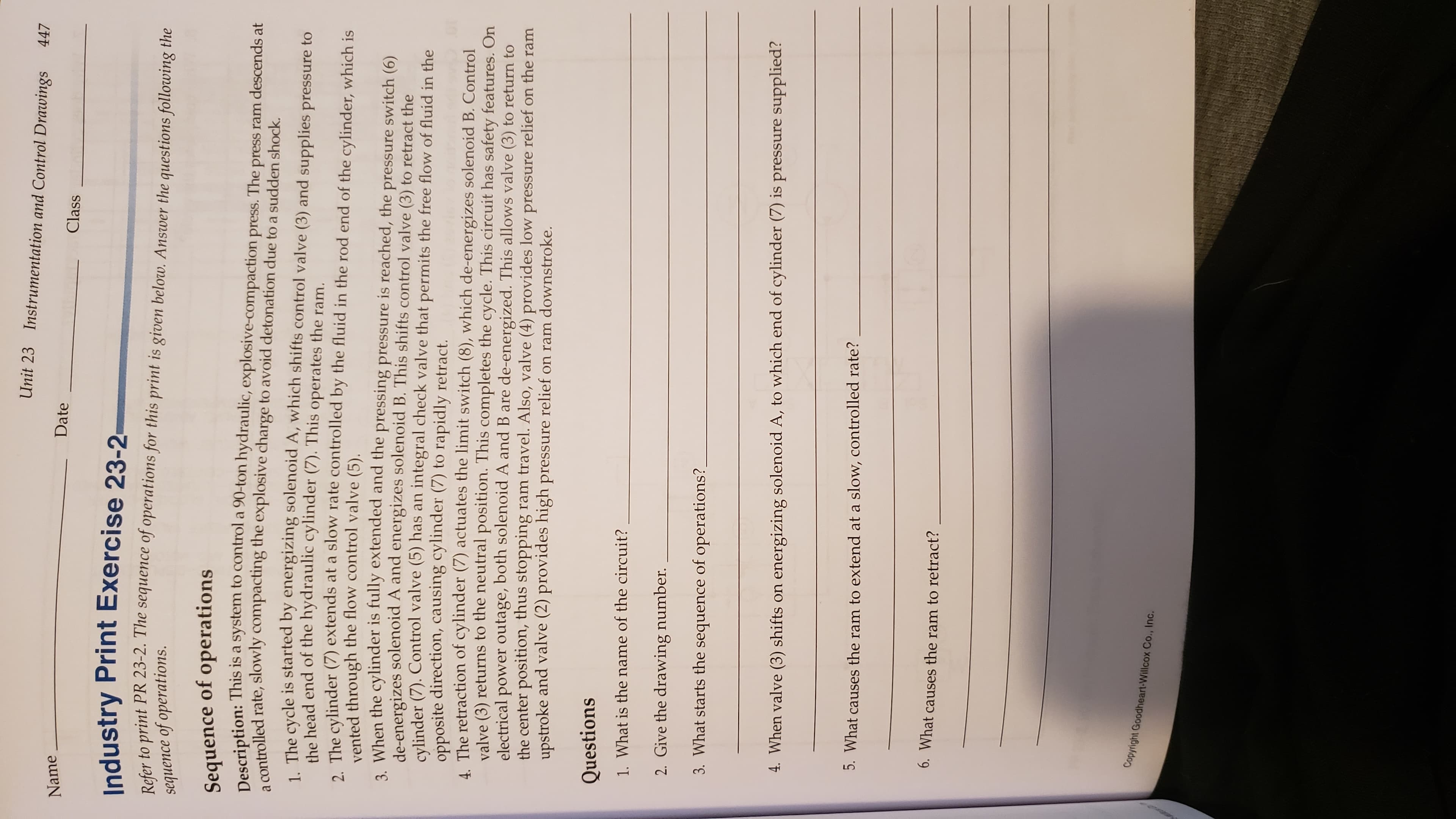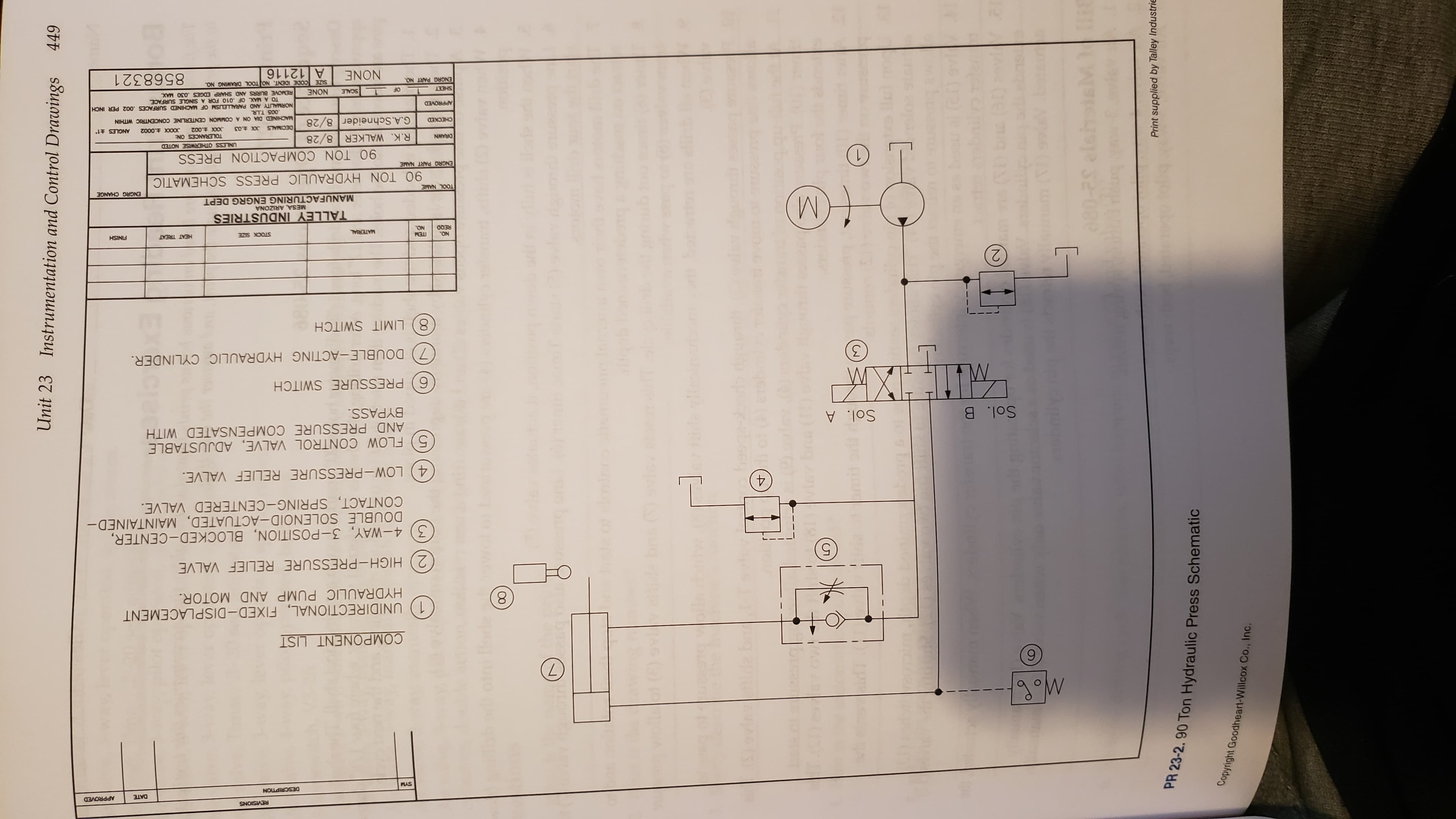Unit 23 Instrumentation and Control Drawings 447 Name Date Class Industry Print Exercise 23-2 Refer to print PR 23-2. The sequence of operations for this print is given below. Answer the questions following the sequence of operations. of operations Sequence Description: This is a system to control a 90-ton hydraulic, explosive-compaction press. Thep a controlled rate, slowly compacting the explosive charge to avoid detonation due to a sudden shock. 1. The cycle is started by energizing solenoid A, which shifts control valve (3) and supplies pressure to press ram descends at the head end of the hydraulic cylinder (7). This operates the ram. 2. The cylinder (7) extends at a slow rate controlled by the fluid in the rod end of the cylinder, which is vented through the flow control valve (5). 3. When the cylinder is fully extended and the pressing pressure is reached, the pressure switch (6) de-energizes cylinder (7). Control valve (5) has an integral check valve that permits the free flow of fluid in the opposite direction, causing cylinder (7) to rapidly retract. AThe retraction of cylinder (7) actuates the limit switch (8), which de-energizes solenoid B. Control valve (3) returns to the neutral position. This completes the cycle. This circuit has safety features. On solenoid A and energizes solenoid B. This shifts control valve (3) to retract the power outage, both solenoid A and B are de-energized. This allows valve (3) to return to electrical the center position, thus stopping ram travel. Also, valve (4) provides low pressure relief on the ram upstroke and valve (2) provides high pressure relief on ram downstroke. Questions 1. What is the name of the circuit? 2. Give the drawing number. 3. What starts the sequence of operations? 4. When valve (3) shifts on energizing solenoid A, to which end of cylinder (7) is pressure supplied? 5. What causes the ram to extend at a slow, controlled rate? 6. What causes the ram to retract? Copyright Goodheart-Willcox Co., Inc. SNIPIISIN APPROVED DATE DESCRIPTION PLAS COMPONENT LIST 1) UNIDIRECTIONAL, FIXED- DISPLACEMENT HYDRAULIC PUMP AND MOTOR. 2) HIGH-PRESSURE RELIEF VALVE 3) 4-WAY, 3-POSITION, BLOCKED- CENTER, DOUBLE SOLENOID-ACTUATED, MAINTAINED- CONTACT, SPRING-CENTERED VALVE. 4) LOW-PRESSURE RELIEF VALVE. 5) FLOW CONTROL VALVE, ADJUSTABLE AND PRESSURE COMPENSATED WITH BYPASS. Sol. A Sol. B 6) PRESSURE SWITCH УХI 7 DOUBLE-ACTING HYDRAULIC CYLINDER. 8) LIMIT SWITCH TEM M HEAT TREAT FINISH MATERIAL STOCK SIZE ON NO. TALLEY INDUSTRIES MESA, ARIZONA MANUFACTURING ENGRG DEPT ENGRG CHANGE TOOL NAME 90 TON HYDRAULIC PRESS SCHEMATIC ENGRG PART NAME 90 TON COMPACTION PRESS UNLESS OTHERWISE NOTED R.K. WALKER 8/28 G.A.Schneider 8/28 NMRA TOLERANCES ON: ANGLES 1 CHECKED MACHINED DIA ON A COMMON CENTERLINE CONCENTRIC WITHIN 005 T.I.R NORMALITY AND PARALLELISM OF MACHINED SURFACES .002 PER INCH TO A MAX. OF .010 FOR A SINGLE SURFACE REMOVE BURRS AND SHARP EDGES .030 MAX ZONE APPROVED OF 1 SCCALE SHEET ENGRG PART NO. SIZE CODE IDENT, NO TOOL DRAWING N0 8568321 ZNE A 12116 449 Unit 23 Instrumentation and Control Drawings 00 669 TO CN DU CH Print supplied by Talley Industrie PR 23-2. 90 Ton Hydraulic Press Schematic Copyright Goodheart-Willcox Co., Inc.
Unit 23 Instrumentation and Control Drawings 447 Name Date Class Industry Print Exercise 23-2 Refer to print PR 23-2. The sequence of operations for this print is given below. Answer the questions following the sequence of operations. of operations Sequence Description: This is a system to control a 90-ton hydraulic, explosive-compaction press. Thep a controlled rate, slowly compacting the explosive charge to avoid detonation due to a sudden shock. 1. The cycle is started by energizing solenoid A, which shifts control valve (3) and supplies pressure to press ram descends at the head end of the hydraulic cylinder (7). This operates the ram. 2. The cylinder (7) extends at a slow rate controlled by the fluid in the rod end of the cylinder, which is vented through the flow control valve (5). 3. When the cylinder is fully extended and the pressing pressure is reached, the pressure switch (6) de-energizes cylinder (7). Control valve (5) has an integral check valve that permits the free flow of fluid in the opposite direction, causing cylinder (7) to rapidly retract. AThe retraction of cylinder (7) actuates the limit switch (8), which de-energizes solenoid B. Control valve (3) returns to the neutral position. This completes the cycle. This circuit has safety features. On solenoid A and energizes solenoid B. This shifts control valve (3) to retract the power outage, both solenoid A and B are de-energized. This allows valve (3) to return to electrical the center position, thus stopping ram travel. Also, valve (4) provides low pressure relief on the ram upstroke and valve (2) provides high pressure relief on ram downstroke. Questions 1. What is the name of the circuit? 2. Give the drawing number. 3. What starts the sequence of operations? 4. When valve (3) shifts on energizing solenoid A, to which end of cylinder (7) is pressure supplied? 5. What causes the ram to extend at a slow, controlled rate? 6. What causes the ram to retract? Copyright Goodheart-Willcox Co., Inc. SNIPIISIN APPROVED DATE DESCRIPTION PLAS COMPONENT LIST 1) UNIDIRECTIONAL, FIXED- DISPLACEMENT HYDRAULIC PUMP AND MOTOR. 2) HIGH-PRESSURE RELIEF VALVE 3) 4-WAY, 3-POSITION, BLOCKED- CENTER, DOUBLE SOLENOID-ACTUATED, MAINTAINED- CONTACT, SPRING-CENTERED VALVE. 4) LOW-PRESSURE RELIEF VALVE. 5) FLOW CONTROL VALVE, ADJUSTABLE AND PRESSURE COMPENSATED WITH BYPASS. Sol. A Sol. B 6) PRESSURE SWITCH УХI 7 DOUBLE-ACTING HYDRAULIC CYLINDER. 8) LIMIT SWITCH TEM M HEAT TREAT FINISH MATERIAL STOCK SIZE ON NO. TALLEY INDUSTRIES MESA, ARIZONA MANUFACTURING ENGRG DEPT ENGRG CHANGE TOOL NAME 90 TON HYDRAULIC PRESS SCHEMATIC ENGRG PART NAME 90 TON COMPACTION PRESS UNLESS OTHERWISE NOTED R.K. WALKER 8/28 G.A.Schneider 8/28 NMRA TOLERANCES ON: ANGLES 1 CHECKED MACHINED DIA ON A COMMON CENTERLINE CONCENTRIC WITHIN 005 T.I.R NORMALITY AND PARALLELISM OF MACHINED SURFACES .002 PER INCH TO A MAX. OF .010 FOR A SINGLE SURFACE REMOVE BURRS AND SHARP EDGES .030 MAX ZONE APPROVED OF 1 SCCALE SHEET ENGRG PART NO. SIZE CODE IDENT, NO TOOL DRAWING N0 8568321 ZNE A 12116 449 Unit 23 Instrumentation and Control Drawings 00 669 TO CN DU CH Print supplied by Talley Industrie PR 23-2. 90 Ton Hydraulic Press Schematic Copyright Goodheart-Willcox Co., Inc.
Elements Of Electromagnetics
7th Edition
ISBN:9780190698614
Author:Sadiku, Matthew N. O.
Publisher:Sadiku, Matthew N. O.
ChapterMA: Math Assessment
Section: Chapter Questions
Problem 1.1MA
Related questions
Question
I need parts 1, 2, and 3, answered pertaining to the print and instructions.

Transcribed Image Text:Unit 23
Instrumentation and Control Drawings
447
Name
Date
Class
Industry Print Exercise 23-2
Refer to print PR 23-2. The sequence of operations for this print is given below. Answer the questions following the
sequence of operations.
of operations
Sequence
Description: This is a system to control a 90-ton hydraulic, explosive-compaction press. Thep
a controlled rate, slowly compacting the explosive charge to avoid detonation due to a sudden shock.
1. The cycle is started by energizing solenoid A, which shifts control valve (3) and supplies pressure to
press
ram descends at
the head end of the hydraulic cylinder (7). This
operates
the
ram.
2. The cylinder (7) extends at a slow rate controlled by the fluid in the rod end of the cylinder, which is
vented through the flow control valve (5).
3. When the cylinder is fully extended and the pressing pressure is reached, the pressure switch (6)
de-energizes
cylinder (7). Control valve (5) has an integral check valve that permits the free flow of fluid in the
opposite direction, causing cylinder (7) to rapidly retract.
AThe retraction of cylinder (7) actuates the limit switch (8), which de-energizes solenoid B. Control
valve (3) returns to the neutral position. This completes the cycle. This circuit has safety features. On
solenoid A and energizes solenoid B. This shifts control valve (3) to retract the
power outage, both solenoid A and B are de-energized. This allows valve (3) to return to
electrical
the center position, thus stopping ram travel. Also, valve (4) provides low pressure relief on the ram
upstroke and valve (2) provides high pressure relief on ram downstroke.
Questions
1. What is the name of the circuit?
2. Give the drawing number.
3. What starts the sequence of operations?
4. When valve (3) shifts on energizing solenoid A, to which end of cylinder (7) is pressure supplied?
5. What causes the ram to extend at a slow, controlled rate?
6. What causes the ram to retract?
Copyright Goodheart-Willcox Co., Inc.

Transcribed Image Text:SNIPIISIN
APPROVED
DATE
DESCRIPTION
PLAS
COMPONENT LIST
1) UNIDIRECTIONAL, FIXED- DISPLACEMENT
HYDRAULIC PUMP AND MOTOR.
2) HIGH-PRESSURE RELIEF VALVE
3) 4-WAY, 3-POSITION, BLOCKED- CENTER,
DOUBLE SOLENOID-ACTUATED, MAINTAINED-
CONTACT, SPRING-CENTERED VALVE.
4) LOW-PRESSURE RELIEF VALVE.
5) FLOW CONTROL VALVE, ADJUSTABLE
AND PRESSURE COMPENSATED WITH
BYPASS.
Sol. A
Sol. B
6) PRESSURE SWITCH
УХI
7 DOUBLE-ACTING HYDRAULIC CYLINDER.
8) LIMIT SWITCH
TEM
M
HEAT TREAT
FINISH
MATERIAL
STOCK SIZE
ON
NO.
TALLEY INDUSTRIES
MESA, ARIZONA
MANUFACTURING ENGRG DEPT
ENGRG CHANGE
TOOL NAME
90 TON HYDRAULIC PRESS SCHEMATIC
ENGRG PART NAME
90 TON COMPACTION PRESS
UNLESS OTHERWISE NOTED
R.K. WALKER 8/28
G.A.Schneider 8/28
NMRA
TOLERANCES ON:
ANGLES 1
CHECKED
MACHINED DIA ON A COMMON CENTERLINE CONCENTRIC WITHIN
005 T.I.R
NORMALITY AND PARALLELISM OF MACHINED SURFACES .002 PER INCH
TO A MAX. OF .010 FOR A SINGLE SURFACE
REMOVE BURRS AND SHARP EDGES .030 MAX
ZONE
APPROVED
OF 1 SCCALE
SHEET
ENGRG PART NO.
SIZE CODE IDENT, NO TOOL DRAWING N0
8568321
ZNE
A 12116
449
Unit 23 Instrumentation and Control Drawings
00
669
TO
CN
DU CH
Print supplied by Talley Industrie
PR 23-2. 90 Ton Hydraulic Press Schematic
Copyright Goodheart-Willcox Co., Inc.
Expert Solution
This question has been solved!
Explore an expertly crafted, step-by-step solution for a thorough understanding of key concepts.
This is a popular solution!
Trending now
This is a popular solution!
Step by step
Solved in 3 steps

Knowledge Booster
Learn more about
Need a deep-dive on the concept behind this application? Look no further. Learn more about this topic, mechanical-engineering and related others by exploring similar questions and additional content below.Recommended textbooks for you

Elements Of Electromagnetics
Mechanical Engineering
ISBN:
9780190698614
Author:
Sadiku, Matthew N. O.
Publisher:
Oxford University Press

Mechanics of Materials (10th Edition)
Mechanical Engineering
ISBN:
9780134319650
Author:
Russell C. Hibbeler
Publisher:
PEARSON

Thermodynamics: An Engineering Approach
Mechanical Engineering
ISBN:
9781259822674
Author:
Yunus A. Cengel Dr., Michael A. Boles
Publisher:
McGraw-Hill Education

Elements Of Electromagnetics
Mechanical Engineering
ISBN:
9780190698614
Author:
Sadiku, Matthew N. O.
Publisher:
Oxford University Press

Mechanics of Materials (10th Edition)
Mechanical Engineering
ISBN:
9780134319650
Author:
Russell C. Hibbeler
Publisher:
PEARSON

Thermodynamics: An Engineering Approach
Mechanical Engineering
ISBN:
9781259822674
Author:
Yunus A. Cengel Dr., Michael A. Boles
Publisher:
McGraw-Hill Education

Control Systems Engineering
Mechanical Engineering
ISBN:
9781118170519
Author:
Norman S. Nise
Publisher:
WILEY

Mechanics of Materials (MindTap Course List)
Mechanical Engineering
ISBN:
9781337093347
Author:
Barry J. Goodno, James M. Gere
Publisher:
Cengage Learning

Engineering Mechanics: Statics
Mechanical Engineering
ISBN:
9781118807330
Author:
James L. Meriam, L. G. Kraige, J. N. Bolton
Publisher:
WILEY